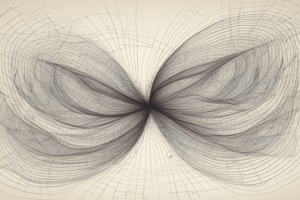Podcast
Questions and Answers
What is the name of the theorem related to homogeneous function?
What is the name of the theorem related to homogeneous function?
- Euler's theorem (correct)
- Rolle's theorem
- Lagrange's theorem
- Fermat's theorem
What is the method used to find the maximum or minimum of a function of several variables?
What is the method used to find the maximum or minimum of a function of several variables?
- Lagrange's multipliers (correct)
- Linear programming
- Newton's method
- Gradient descent
What is the term used to describe the total derivative of a function with respect to one of its variables?
What is the term used to describe the total derivative of a function with respect to one of its variables?
- Differential coefficient (correct)
- Exact differential
- Partial derivative
- Total derivative
What is the exact differential in calculus?
What is the exact differential in calculus?
What is the term used to describe a function that has the same property at every point?
What is the term used to describe a function that has the same property at every point?
What is the purpose of Lagrange's multipliers in optimization?
What is the purpose of Lagrange's multipliers in optimization?
What is a characteristic of a homogeneous function?
What is a characteristic of a homogeneous function?
What is the total differential coefficient of a function?
What is the total differential coefficient of a function?
What is the main application of Euler's theorem on homogeneous functions?
What is the main application of Euler's theorem on homogeneous functions?
What is the relationship between the partial derivatives of a function that has an exact differential?
What is the relationship between the partial derivatives of a function that has an exact differential?
Flashcards are hidden until you start studying
Study Notes
Partial Differentiation
- A partial derivative of a function of multiple variables is its derivative with respect to one of its variables, while keeping the others constant.
- Notation: ∂f/∂x or fx, where f is the function and x is the variable with respect to which we are differentiating.
- Geometrically, the partial derivative represents the rate of change of the function in the direction of the variable with respect to which we are differentiating.
Total Differential Coefficients
- The total differential of a function of multiple variables is a measure of the total change of the function with respect to all its variables.
- Notation: df, where f is the function.
- The total differential is used to approximate the change in the function near a point.
Exact Differential
- An exact differential is a differential that can be expressed as the differential of a function.
- Notation: df, where f is the function.
- An exact differential satisfies the exactness condition, which is a necessary and sufficient condition for a differential to be exact.
Euler's Theorem on Homogeneous Function
- A homogeneous function of degree n is a function that satisfies the equation f(tx, ty, ...) = t^n f(x, y, ...), where t is a scalar and x, y, ... are the variables.
- Euler's theorem states that for a homogeneous function of degree n, the sum of the partial derivatives of the function with respect to each variable, multiplied by the variable, is equal to n times the function.
- Notation: x (∂f/∂x) + y (∂f/∂y) + ... = n f(x, y, ...)
Maxima & Minima of a Function of Several Connected Independent Variables (Lagrange's Multipliers)
- Lagrange's multipliers are used to find the maximum or minimum of a function of several connected independent variables, subject to certain constraints.
- The method involves adding a Lagrange multiplier to the function, and then finding the partial derivatives of the new function with respect to each variable and the Lagrange multiplier.
- The values of the variables and the Lagrange multiplier that satisfy the partial derivatives are the values that maximize or minimize the function.
Partial Differentiation
- A partial derivative of a function of multiple variables is its derivative with respect to one of its variables, while keeping the others constant.
- Notation: ∂f/∂x or fx, where f is the function and x is the variable with respect to which we are differentiating.
- Geometrically, the partial derivative represents the rate of change of the function in the direction of the variable with respect to which we are differentiating.
Total Differential Coefficients
- The total differential of a function of multiple variables is a measure of the total change of the function with respect to all its variables.
- Notation: df, where f is the function.
- The total differential is used to approximate the change in the function near a point.
Exact Differential
- An exact differential is a differential that can be expressed as the differential of a function.
- Notation: df, where f is the function.
- An exact differential satisfies the exactness condition, which is a necessary and sufficient condition for a differential to be exact.
Euler's Theorem on Homogeneous Function
- A homogeneous function of degree n is a function that satisfies the equation f(tx, ty, ...) = t^n f(x, y, ...), where t is a scalar and x, y, ... are the variables.
- Euler's theorem states that for a homogeneous function of degree n, the sum of the partial derivatives of the function with respect to each variable, multiplied by the variable, is equal to n times the function.
- Notation: x (∂f/∂x) + y (∂f/∂y) + ... = n f(x, y, ...)
Maxima & Minima of a Function of Several Connected Independent Variables (Lagrange's Multipliers)
- Lagrange's multipliers are used to find the maximum or minimum of a function of several connected independent variables, subject to certain constraints.
- The method involves adding a Lagrange multiplier to the function, and then finding the partial derivatives of the new function with respect to each variable and the Lagrange multiplier.
- The values of the variables and the Lagrange multiplier that satisfy the partial derivatives are the values that maximize or minimize the function.
Studying That Suits You
Use AI to generate personalized quizzes and flashcards to suit your learning preferences.





